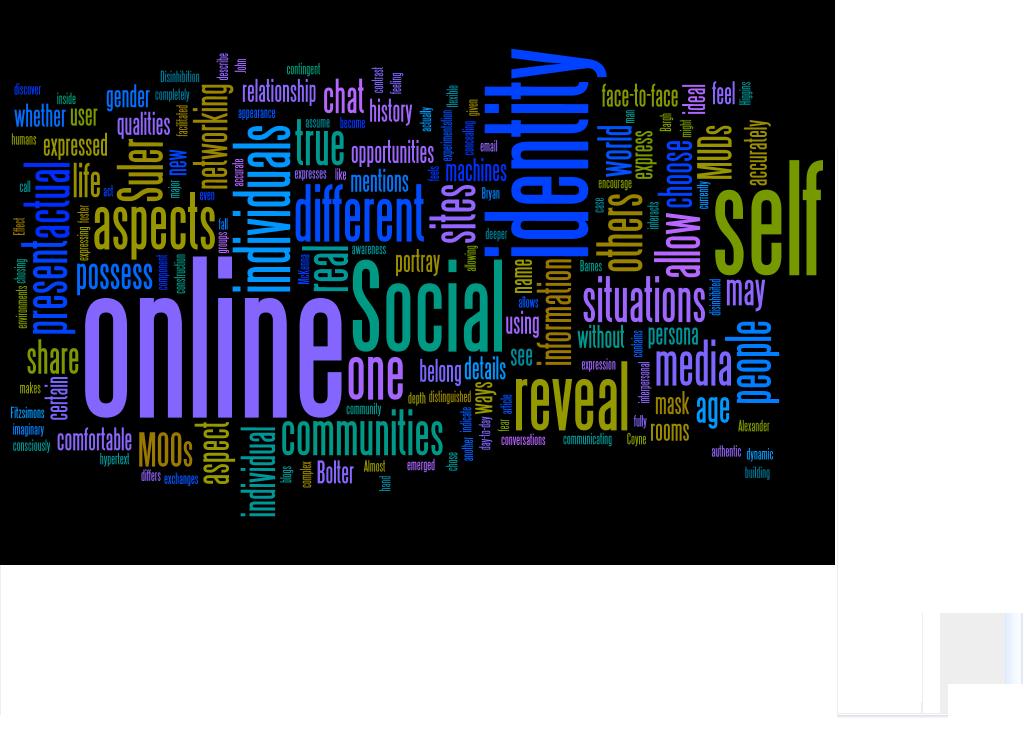
“Social media is interpersonal media. It supports the sharing of personal exchanges in new and unique ways. It is not the relationship between humans and machines that makes social media powerful. In contrast, it is the relationship facilitated between people through the use of machines to foster the building of social networks and a new network society.” (Barnes, Susan. 2009, p.23)
Social networking sites and online communities have, as Bryan Alexander (2006) states, “emerged as a major component of the Web 2.0 movement”. When using these sites, individuals can present themselves in a variety of different ways by choosing whether or not to accurately reveal their name, age, gender, physical appearance, personality and history. Individuals’ online identity is shaped by the details and information they do or do not indicate about themselves and the persona they present in each online community they belong to. As Bolter, (2001, p.190) mentions, “…we write both to express, to discover, and to share who we are, and in a postmodern age our identity is, like hypertext, dynamic, flexible, and contingent.”
In professional or work related online communities, individuals may chose to accurately reveal certain details (name, age, gender) about themselves while omitting others (history, groups you belong to). On the other hand, multi-user virtual environments such as MOOs and MUDs encourage or even require individuals to assume a completely imaginary persona. “Almost the sole purpose of chat rooms and MUDs and MOOs is the construction of and experimentation with the users’ identity” (Bolter, 2001, p.198). Most other social networking sites and online communities fall somewhere in between, allowing for the individual to choose the depth of information they wish to share and whether that shared information is accurate or not.
“Higgins (1987) distinguished between ideal, ought, and actual self-concepts: the ideal self contains those qualities one strives someday to possess, the ought self those qualities one feels obligated to possess, and the actual self the one actually expresses to others at present.” (Bargh, McKenna, & Fitzsimons, 2002). The true self differs from these three as it is what one currently possess, but unlike the actual self, it is not fully expressed in social situations.
Wiszniewski and Coyne (2002) describe how whenever an individual interacts in a social setting they portray a “mask” of their identity. This “mask” allows the individual to choose what aspects of their identity they reveal. Individuals who act very different in the ‘real’ world than how they are really thinking and feeling inside, may feel more comfortable revealing and expressing certain aspect of themselves without fear of persecution in online situations.
John Suler mentions in his article The Online Disinhibition Effect (2004), “online identity has given people the opportunity to feel comfortable in wide-ranging roles, some of which may be underlying aspects of the user’s life that the user is unable to portray in the real world.” These opportunities may allow for the expression of ones true self. “Our true identity tends to be what we reveal about ourselves spontaneously, often right on the surface for others to see but without our being consciously awareness of it” (Suler, 2004). For some people, online situations allow them to become, as Suler (2004) says, “disinhibited” and reveal aspects of their personalities they wouldn’t normally share. A young man might be the ‘life of the party’ in the online chat room, yet be very shy in his day-to-day life. In this case it would seem that his outgoingness when communicating online is an aspect of his true self, whereas his shyness in face-to-face situations is an aspect of his actual self. Both are important aspects of his identity.
Individuals present variant aspects of their identity when using different media such as social networking sites, Blogs, online chat rooms, MOOs and MUDs, email, Skype, ‘real’ world relationships, and face-to-face conversations. Each of these different situations allow for an individual to express certain aspects of themselves, while concealing others. It is important to remember that, “The self expressed in one modality is not necessarily deeper, more real, or more authentic than another. They allow us to see the different perspectives of that complex thing we call identity.” (Suler, 2004).
Resources:
Bargh, J., McKenna, K. and Fitxsimons, G. (2002). Can You See the Real Me? Activation and Expression of the “True Self” on the Internet. Journal of Social Issues, 58, 1 (33-48)
Barnes, Susan B. (2008). Understanding social media from the media ecological perspective. In Mediated Interpersonal Communication Eds. Elly Konijn, Inc NetLibrary, Elly Konijn. Boston: Routledge.
Bolter, D.J. (2001). Writing Space: Computers, Hypertext, and the Remediation of Print.London: Lawrence Erlbaum Associates, Publishers.
Higgins, E.T. (1987). Self-discrepancy theory. Psychological Review, 94, 112-1134.
Suler, J. (2004). The Online Disinhibition Effect. The Psychology of Cyberspace. Retrieved from: http://www-usr.rider.edu/~suler/psycyber/disinhibit.html
Wiszniewski, D. and Coyne, R. (2002). Mask and Identity: The Hermeneutics of Self-Construction in the Information Age.In K. Renninger & W. Shumar (Eds.), Building Virtual Communities: Learning and change in cyberspace. (pp.191-192). New York: Cambridge University Press.
